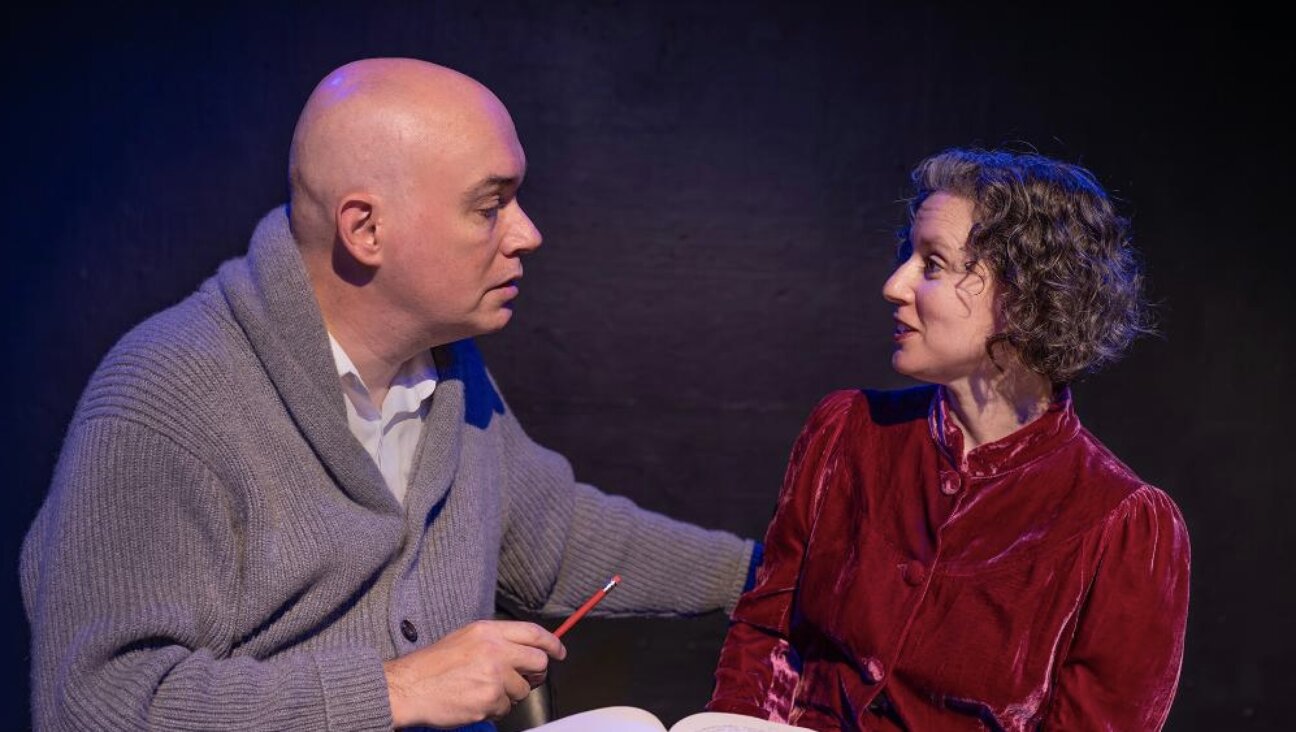Sara Erenthal Turns Her Unhappy Ultra-Orthodox Childhood Into Art

Graphic by Angelie Zaslavsky
“Eidele Meidele,” the braided girl // Copyright Camilla Cerea
A narrow bed with light blue bedding, flanked by two nightstands, is propped up against the wall right behind the glass doors. A Hebrew book of psalms lies on one nightstand, a vase with dried flowers on the other. One of its drawers is opened, and contains a pile of family photographs. A pair of tights dangles out of another. On the wall across from the bed hangs a portrait of a man with a long beard, peyes, and a white yarmulka. It’s a collage titled “Father” that uses fabric, twine rope and staples. Entering Soapbox Gallery in Prospect Heights, Brooklyn, feels like walking into someone’s home. And this, says Sara Erenthal, whose first solo exhibition titled “Be!” is on display here, is fully intentional.
The show is small (apart from the bedroom, which is titled “Good Night Hindy”, there are only a few other art installations) but tells a powerful story: Erenthal, 33, grew up in the ultra-Orthodox, anti-Zionist sect Neturei Karta. She spent the first four years of her life in Jerusalem’s ultra-Orthodox Mea Shearim neighborhood; then her family moved to Boro Park, Brooklyn, and also lived for a while in Monsey and Kiryas Joel, New York. The photographs in the nightstand drawer show her as a serious looking girl, dressed in modest skirts and blouses, her hair dark, long and braided.
The braids — a hairstyle she was forced to wear, she says — are represented in the show as well: A five foot papier-mâché head hangs on one wall, with a total of 1,600 foot of manila rope forming two gigantic braids that rest on the floor.
Erenthal, who has short curly hair, two nose rings, and faded Henna tattoos on her arm, says the sculpture represents her unhappy childhood. “I was not cut out for that world,” she says, adding that her harsh father and a lack of opportunity for individual expression made it difficult for her to fit into the strict lifestyle of ultra-Orthodoxy.
At the age of 17 an engagement was arranged for her (“to fix all my problems”) but before Erenthal even met the man, she says she ran away from home. After staying with some distant relatives, she joined the Israeli Defense Forces, and spent 21 months in the army. “It taught me about life,” says Erenthal. Afterwards, she lived for a while in Eilat, moved back to New York, worked at an office job for a while, returned to Israel, and travelled through India, Thailand and Laos for two years. It was during her travels that she first started drawing, using pens and sharpies. She says she created a mural for an Indian restaurant and designed clothes for other backpackers. Upon her return to New York in 2012, she received support from Footsteps, an organization that helps individuals who have left religious Jewish communities, to be able to intern with a local artist. She has participated in several group exhibitions and sold some of her artwork to private collectors.
“Running away from home was scary,” she says. “Being an artist is also scary.” Getting by can be tricky, but Erenthal calls herself a “hustler”: “Sometimes I go on the street and do henna.”
Perhaps most importantly, she has already experienced how painful making art can be. The most gripping installation of her show is a short black-and-white video, which shows Erenthal, screaming, squirming and crying, as her nude upper body is tied up with tefillin straps. The sound is muted. “I was in real pain,” Erenthal recalls, looking at the video, then averting her gaze. “It still hurts to watch.”
On view until Saturday, September 13, 2014 at Soapbox Gallery, 636 Dean Street, Brooklyn, New York 11238. Closing ceremony and concert on Friday, September 12, 2014, 7-10 pm.

















